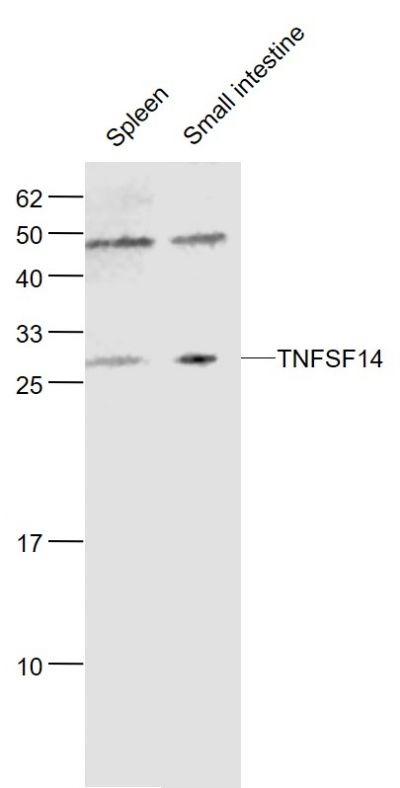购物车
全部删除  您的购物车当前为空
您的购物车当前为空
别名 tumor necrosis factor (ligand) superfamily, member 14, TR2, LTg, LIGHT, HVEML, CD258
Anti-LIGHT/TNFSF14 Polyclonal Antibody 是一种 Rabbit 抗体,靶向 LIGHT/TNFSF14。Anti-LIGHT/TNFSF14 Polyclonal Antibody 可用于 ELISA,WB。
Anti-LIGHT/TNFSF14 Polyclonal Antibody 是一种 Rabbit 抗体,靶向 LIGHT/TNFSF14。Anti-LIGHT/TNFSF14 Polyclonal Antibody 可用于 ELISA,WB。
| 规格 | 价格 | 库存 | 数量 |
|---|---|---|---|
| 50 μL | ¥ 1,165 | 5日内发货 | |
| 100 μL | ¥ 1,965 | 5日内发货 | |
| 200 μL | ¥ 2,790 | 5日内发货 |
| 产品描述 | Anti-LIGHT/TNFSF14 Polyclonal Antibody is a Rabbit antibody targeting LIGHT/TNFSF14. Anti-LIGHT/TNFSF14 Polyclonal Antibody can be used in ELISA,WB. |
| 别名 | tumor necrosis factor (ligand) superfamily, member 14, TR2, LTg, LIGHT, HVEML, CD258 |
| Ig Type | IgG |
| 反应种属 | Human,Mouse (predicted:Rat) |
| 验证活性 | Sample: Spleen (Mouse) Lysate at 40 μg Small intestine (Mouse) Lysate at 40 μg Primary: Anti-TNFSF14 (TMAB-01068) at 1/1000 dilution Secondary: IRDye800CW Goat Anti-Rabbit IgG at 1/20000 dilution Predicted band size: 26 kDa Observed band size: 26 kDa  |
| 应用 | ELISAWB |
| 推荐剂量 | WB: 1:500-2000; ELISA: 1:500-5000 |
| 抗体种类 | Polyclonal |
| 宿主来源 | Rabbit |
| 亚细胞定位 | Tumor necrosis factor ligand superfamily member 14, membrane form: Cell membrane; Single-pass type II membrane protein.Tumor necrosis factor ligand superfamily member 14, soluble form: Secreted.Isoform 2: Cytoplasm. |
| 组织特异性 | Predominantly expressed in the spleen but also found in the brain. Weakly expressed in peripheral lymphoid tissues and in heart, placenta, liver, lung, appendix, and kidney, and no expression seen in fetal tissues, endocrine glands, or nonhematopoietic tu |
| 构建方式 | Polyclonal Antibody |
| 纯化方式 | Protein A purified |
| 性状 | Liquid |
| 缓冲液 | 0.01M TBS (pH7.4) with 1% BSA, 0.02% Proclin300 and 50% Glycerol. |
| 浓度 | 1 mg/mL |
| 研究背景 | LIGHT protein is a type II transmembrane protein and a tumor necrosis factor (TNF) ligand superfamily member (TNFSF14). LIGHT is expressed on activated T cells and immature dendritic cells and its receptors have been identified as lymphotoxin-Beta receptor (LTBetaR) and the herpesvirus entry mediator (HVEM), both of which lack the cytoplasmic sequence termed as "death domain." LIGHT is first identified as HVEM ligand (HVEM-L) and a deterrent to herpesvirus infection according to its ability to compete with HSV glycoprotein D for HVEM binding. As a T cell-derived costimulatory ligand, TNFSF14 plays a crucial role in T cell activation and proliferation by LIGHT-LTBetaR interaction, and it is necessary and sufficient for LIGHT-mediated apoptosis of tumor cells. Additionally, recent studies also establish a direct role for LIGHT in NK activation/expansion via LIGHT-HVEM interaction, and thus breaking T-cell tolerance at the tumor site. Accordingly, LIGHT is suggested to be involved in CTL-mediated tumor rejection, allograft rejection and graft versus host disease. Although known as lymphotoxin-Gamma, LIGHT plays a minimal role in lymphoid tissue development in contrast with LT-Alpha and Beta. This protein was also demonstrated to inhibit TNF-Alpha-mediated but not Fas- or TRAIL-mediated apoptosis of human primary hepatocytes. |
| 免疫原 | KLH conjugated synthetic peptide: human TNFSF14 |
| 抗原种属 | Human |
| 基因名称 | TNFSF14 |
| 基因ID | |
| 蛋白名称 | Tumor necrosis factor ligand superfamily member 14 |
| Uniprot ID | |
| 功能 | Cytokine that binds to TNFRSF3/LTBR. Binding to the decoy receptor TNFRSF6B modulates its effects. Activates NFKB, stimulates the proliferation of T-cells, and inhibits growth of the adenocarcinoma HT-29. Acts as a receptor for Herpes simplex virus. |
| 分子量 | Theoretical: 26 kDa. |
| 储存方式 | Store at -20°C or -80°C for 12 months. Avoid repeated freeze-thaw cycles. |
| 运输方式 | Shipping with blue ice. |
| 存储 | store at low temperature | store at -20°C |